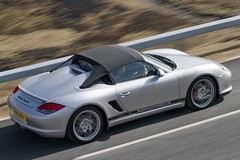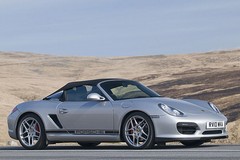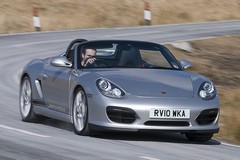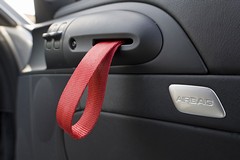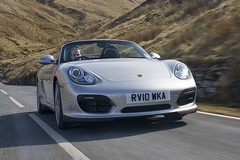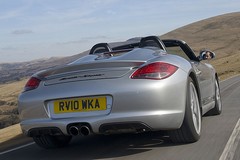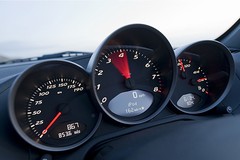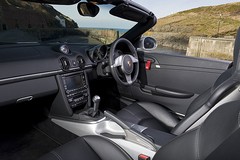Driven: Porsche Boxster Spyder
Porsche 'does a GT3' with this stripped-down Boxster. Riggers has a go
Thank God (or your preferred deity or absence thereof) that Porsche is still brave enough to make cars like the new Boxster Spyder.
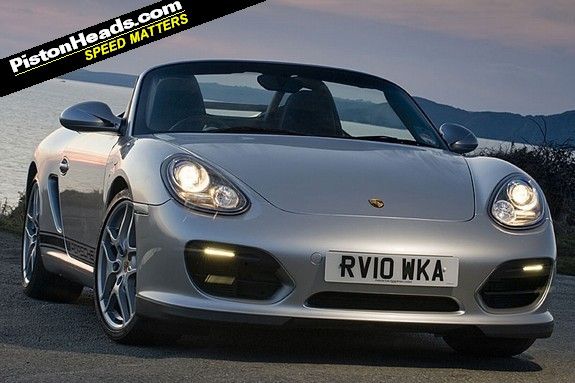
Porsche might earn its living these days from diesel-powered 4x4s, but the appearance of something like the Spyder on the Porsche price lists proves that the folks at Weissach still put plenty of heart and soul into their products.
Consider the objective facts and it's hard to make a case for the Spyder. For a weight saving of just 80kg (which is rapidly diminished as soon as you delve into the extensive options list) and a pretty meagre power boost of 10bhp (316bhp) and 7lb ft (273lb ft) of torque over a Boxster S, you'll have to put up with a fiddly two-piece manual hood, and very little in the way of creature comforts.
The performance gain isn't extraordinary either, although 0-62mph in 4.8secs and a top speed of 166mph (124mph with the hood in place) is hardly to be sniffed at. But it's only two tenths of a second quicker to 62mph than a Boxster S, and top speed actually drops 4mph from 170mph.
All for the princely sum of (at least) £46,387. That's £3879 more than a Boxster S, although most early customers are also apparently ticking quite a few options boxes - the average price for the 50 UK cars ordered so far is around £56k.
It's quite easy to understand why Porsche reckons that the Spyder is going to be a little too much for 90 per cent of Boxster customers to stomach.
But what true petrol head really cares about objective facts? The big question is this: is the Spyder a classic case of 'less is more' or are you merely going to be paying more for less?
The extra sense of occasion you get with the Spyder certainly helps to justify that price tag. Aside from the curvy 911 Speedster-style twin-humped aluminium engine cover and the new roof, the differences between the Spyder and the regular Boxster S are subtle, but the overall effect is significant.
The devil really is in the detail here. On the outside, there are unique 19in alloy wheels, Porsche logos running along the base of the door line and smaller, more discreet LED daytime running lights. Inside, there are lightweight door trims, fabric loops instead of door handles and lightweight interior door trims, all of which saves around 2kg. Even the top cowl of the instrument cluster has been removed, shaving off precious grams.
More conventional weight saving comes in the form of dumping the radio (-3kg) and air-con (-12kg), while standard carbon fibre-backed sports seats save a further 12kg. The biggest weight savings come from the aluminium doors (-15kg) and the swapping of the one-piece electric hood for the manual two-piece item (-21kg). All small details but they add-up to a suitably pared-down club racer feel.
What they don't do is really make a massive difference to the way the car behaves on the road. After all, stick a decently chunky adult in the passenger seat and you've lost your hard-won weight saving in one fell swoop. Yes, the turn-in is a smidgen sharper, and the Spyder does feel a little lighter on its feet when you're changing direction, but the biggest difference - unfortunately - is that the 20mm lower ride height makes a rippled B-road a noticeably more jarring experience.
And yet - somehow - the Spyder still manages to feel special. Maybe it's just that you're that much more exposed, that bit less cosseted than in a regular Boxster, but the Spyder feels more alive, vocal, visceral. Just as with the 911 GT3 - very much the Spyder's spiritual big brother - the Spyder requires you to take an active part in proceedings. And that is what a hardcore roadster should be all about.
In fact, the Spyder has moved the Boxster closer than ever to the Lotus Elise concept. Imagine an Elise with immaculate build quality, a glorious-sounding flat six, and a roof that's fiddly but effective and that, essentially, is what Porsche has created.
Get the Spyder on a track (as we get a chance to do at Porsche's Silverstone-based experience centre handling facility) and the hardcore Boxster really comes into its own. The extra sharpness in the chassis makes itself felt more keenly, and the lower ride height helps to keep the Spyder cornering flat and hard.
Specify your Spyder with the carbon-ceramic brakes (a not insignificant £5349 extra) and you'll be treated to almost fade-free braking, while the lighter touch they require helps the Boxster feel even more delicately precise.
We're still not totally sold on the £1962 PDK twin-clutch gearbox, however. It will definitely make you quicker on a track day, but it does rob the driver of a teeny amount of involvement. If you do plump for PDK, the £277 wheel-mounted paddles are definitely worth investing in, as they do away with the occasionally awkward rocker switches.
In the end, whether you go for a Spyder will probably depend on where your priorities lie. It will also depend on whether you want to use it as your primary transport. As an everyday proposition, the Spyder is not really practical. And performance junkies probably won't see the point.
But as a toy for weekends and track days, then the Spyder makes a seriously appealing case for itself, if not exactly a sensible one. Like we said, thank God Porsche still makes cars like this.
Gassing Station | General Gassing | Top of Page | What's New | My Stuff

